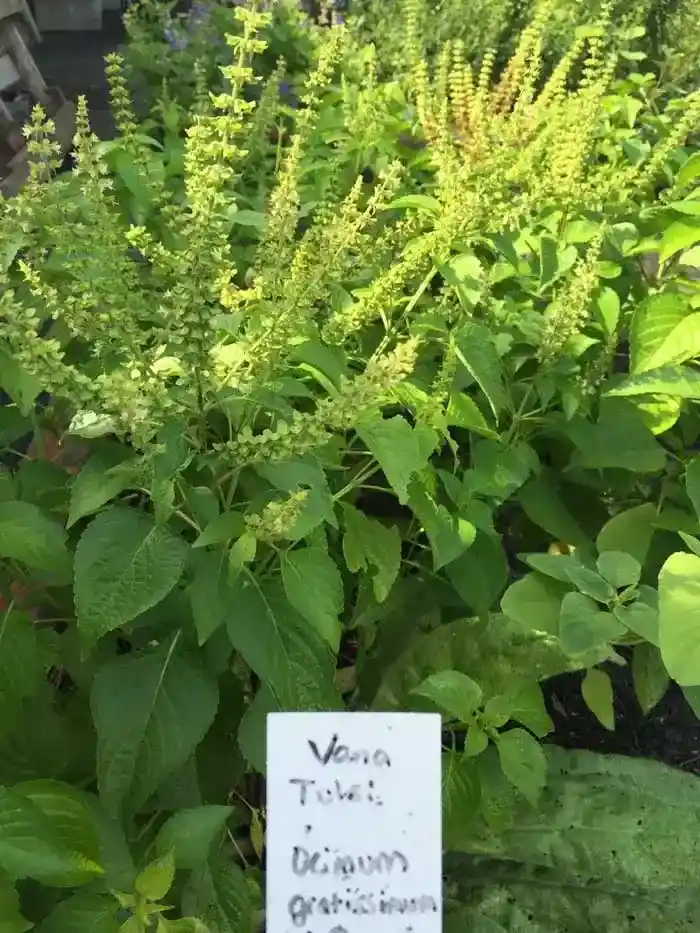- Special Place in Hindu Mythology
- Herb Loved All Over the World
- Basil Plant Loves Direct Sunlight
- Death Due to Overwatering
- Selecting the Right Plant Pot
- Epsom Salt Helps in the Plant Growth
- Cutting the Main Branch Promotes Back Budding
- Potential Insect Attacks
- Removing Seedlings from Basil
- Regrow New Plants from Seedlings
- Is it better to grow basil inside or outside?
- What is the best way to grow basil?
- Why do my basil plants keep dying?
- What is the benefit of basil?
- What is the lifespan of the Basil plant?
- Why do we worship the Tulsi plant?
- Tulsi Leaves Have Antibiotic & Antibacterial Properties
- Chewing Tulsi Helps in the Bad Throat
- Helps in Cough and Vata Problems
- Builds immunity
- Why Water Holy Basil Every Day?
Basil is among the most common Indian houseplants. Locally known as Tulsi- a wide range of Indian homes have this plant because of its cultural & religious significance. Let’s see what makes the Tulsi plant so special.
Special Place in Hindu Mythology
There are different legends about the origin & significance of Tulsi that establish its connection with the Hindu God Lord Vishnu. As per a legend, Tulsi is considered as Lord Vishnu’s wife – Lakshmi. Another legend says that Tulsi is the reincarnation of the determined and powerful Vrinda. Her husband – Jalandhar was a demon born from Lord Shiva’s rage.
Vaishnav legend on the other hand – regards Tulsi as born during the Samudra Manthan event – when Lord Vishnu’s happy tears fell in Amrita after which Tulsi was formed. Different people follow different legends – however, Tulsi is undoubtedly a plant that is worshipped every day in Hindu households. More importantly – the medicinal properties of this plant make it one of the most important houseplants.
When you have all the reasons to have such a miraculous plant around – knowing how to take its care becomes very important. This is what this article is all about. If you wish to learn how to grow a healthy Tulsi plant at your home – read this article till the end. We will be covering different points and make sure that you don’t miss anything. This article is your one-stop guide to learn everything about basil plant care. However, to understand this you have to learn more about different variants of this plant.
Herb Loved All Over the World
Vietnam, Thailand, Italy, African Continent, China, USA – are some of the countries where there are different variants of Basil (Ocimum) that can be found. However – as far as India is concerned there are four common types of Tulsi variants. These four common variants are –

1. Vana Tulsi
2. Krishna Tulsi
3. Rama Tulsi
4. Kapoor Tulsi.
Generally, Rama Tulsi is grown in Indian homes for the purpose of worship. Some houses may have one or more than one variant of Tulsi at their home. Krishna Tulsi and Kapoor Tulsi are heavily used in medicinal preparations in Ayurveda. Unlike other houseplants – Tulsi is a sturdy plant. However, considering the following points can help you grow a healthy Tulsi plant.
Basil Plant Loves Direct Sunlight
Usually, this plant is kept in the courtyard of houses or at the entrances. Ensuring that the plant gets abundant sunlight, can be one way of ensuring its healthy growth. If the plant is covered in the shade for a long duration, that can negatively affect the growth of this plant.
Death Due to Overwatering
Overwatering is the most common reason why the Tulsi plant dies. Thus, knowing how often to water basil is important. There can be multiple members in a household- watering the plant as a part of their everyday rituals. This may result in the growth of fungus on the roots & result in the death of the plant. To avoid this you can improve the drainage of your plant pot. To do this, mix some sand along with the garden soil. This can improve the drainage in the soil. Secondly – you can also consider increasing the size of drainage holes of the pot. These two remedies can allow the quicker drainage of water – thus eliminating the possible risk of fungus infection at the plant root. How often water basil? Well, watering this plant once a day can be sufficient.
Selecting the Right Plant Pot
The special plant pot in which the Tulsi plant is grown is called Vrindavan. These can be made from Marble, Stone, Concrete, etc. These are vertical in shape and their designs are often inspired by the shapes of Indian Temples and feature some religious symbols. Based on the availability of space, ease of movement, and convenience you can choose a Vrindavan that can match your expectations.
However, for the rest of your plants, you can check Fiberglass Planters.
Epsom Salt Helps in the Plant Growth
If you are looking for a supplement that can make your plant look greener and help it grow at a fast speed – then you can consider using Epsom salt (MgSO4). This chemical helps plants in chlorophyll formation, thus promoting the pace of plant growth. You can take a small spoon of this salt and mix it in one liter of water and then simply spray it on a plant using a spray pump (don’t spray all the mixture on the plant in one go). You can repeat the spray after 25 days. If you are using the Tulsi leaves for consumption purposes – don’t eat leaves up to three days after the spray. Make sure you have thoroughly washed the plant on the next day of spray, and only then you can consider using Tulsi leaves for edible purposes. Remember – Epsom Salt shall be completely washed off from leaves before you eat those. This easy hack can be used for your other houseplants as well.
Cutting the Main Branch Promotes Back Budding
Once you think that your plant has achieved the desired height, you can then cut the main branch of your Tulsi plant. This promotes the back budding among & initiates the growth of newer shoots. The plant becomes denser as the volume of the plant increases. With this easy hack, you can promote the lateral growth of the Tulsi plant.
Potential Insect Attacks
Tulsi plant grows well in summer. However, in winter there can be a potential risk of insect attack on this plant. The common insects or pests that this plant faces involve aphids, mildew, whiteflies, Seedling blight, etc.
You can either opt for chemical plant medicines or choose natural chemical insecticides such as Neem Oil to deal with these pests. Mix 8-10 drops of Neem Oil in one liter of water & then simply spray it on your plant. This can help you arrest the spread of pests. If the Neem oil doesn’t work in your case – you can then consider switching to chemical pesticides.
Caterpillar/Worms Attack –
In this case, you can opt for manually picking up the worms and collecting those in a box. If you are not comfortable picking up live worms with your hands, then you can also use the soap water solution method. Prepare a dishwashing soap solution and mix it in water. Spray this soap solution. This kills all the worms. Beware of the concentration of spray solution as the harsh /concentrated spray may negatively affect the plant. Wash the plant the next day. This will clear all the soap extract. This is a proven remedy that can assure you of relief in case of a worm attack.
Keep checking your plant periodically. Identifying such attacks in their preliminary stage can help in timely pest management.
Removing Seedlings from Basil
Every plant has a fixed life cycle. When a plant is ready to produce new seeds, it may assume that its function is over and start declining. The same is true for the Tulsi plant as well. However, removing the seed pots can trigger the plant to keep growing and you can extend its life span up to several months. Remember like all other houseplants – Tulsi also has a limited life. This is why the next point on our list is very important.
Regrow New Plants from Seedlings
The seed pots that you remove from the plants can be dried in the sunlight. Rubbing those on the hands and then growing new seedlings from them is a way of regrowing a new plant. Once you realize that the plant has started to decline – that’s the time when you can start planning for a replacement.
Now, let’s see some commonly asked questions about growing basil.
Is it better to grow basil inside or outside?
Outside. This allows the plant to get abundant sunlight which it thoroughly enjoys & grows rapidly. Growing basil inside may require you to put it in a place where it can receive direct sunlight. Remember some amount of sunlight exposure is necessary for the basil plant to grow. If you are growing basil for edible purposes – you can choose to grow it using fiberglass planters in your backyard garden.
What is the best way to grow basil?
Ensuring enough sunlight, avoiding overwatering, preventing plants from pest attacks – this is the best way to grow basil. When the necessary conditions are met – the plant can rapidly grow.
Why do my basil plants keep dying?
Overwatering, shock, lack of sunlight, and pest attack – these are the common reasons why your basil plant may die. Root rotting that leads to the development of fungus is the most common reason for the death of the basil plant. Check for these reasons and determine which might be the potential reason for the death of your plant.
What is the benefit of basil?
Basil leaves can cure common colds, itching in the throat, and cough giving instant relief. You can simply add basil leaves to lemon tea and then have it with a drop of honey. This home remedy works most of the time (if not, consult your doctor immediately). The other benefit of the basil plant is the high amount of oxygen that it provides as compared to other houseplants.
What is the lifespan of the Basil plant?
3 years is the lifespan up to which a basil plant can live if utmost precaution and care are taken.
Why do we worship the Tulsi plant?
This plant is considered auspicious and believed to be a representation of prosperity and abundance, thus is worshipped every day. Different legends highlight the relevance and importance of this plant.
Since we have covered the basics of basil plant care, let’s move to some of the other interests of this plant.
To know more about gardening and plant care tips you can check the blog section by Bonasila & learn more.
Tulsi Leaves Have Antibiotic & Antibacterial Properties
In case of a honey bee bite – you can squeeze the juice of Tulsi leaves and apply it to the wound. This can soothe the area of the wound and bring down the pain. These properties of this plant make it highly effective as a home remedy.
Chewing Tulsi Helps in the Bad Throat
Thoroughly wash Tulsi leaves and chew those with one or two pepper and sugar grains. Chew this juice for some time and you can see some relief in the bad throat.
Helps in Cough and Vata Problems
Since Tulsi leaves possess inherent warmness – it is highly effective in clearing out the cough from the body. The aroma of leaves is strong and can relieve Nausea and Vomiting problems. It is highly effective in dry cough and consistent coughing. Basil seeds are also used in the bronchitis treatment.
Builds immunity
Toxins in the body affect the regular functioning of the body. Tulsi leaves help in clearing these toxins and building the immunity of the body.
Why Water Holy Basil Every Day?
Watering Holy Basil can be perceived as a religious ritual – however, the reason has a deeper significance. Watering the plant is one way of expressing gratitude for this go-to plant which plays a crucial role in most home remedies. Also, watering every day brings you close to this plant. Thus this is a well-thought practice that ancestors interweaved with everyday rituals.
We hope this article helped you in gaining a perspective about this highly important plant. Do follow the tips shared with you and check if it helps you in growing your Tulsi plant. If gardening is your passion or you are just thinking of giving it a try; you can check out Bonasila – a leading fiberglass planters manufacturer based out of India. Their designer planters are changing the way plants are now being included in the design process.
What are your thoughts about growing a healthy basil plant? Do let us know in the comment section.







